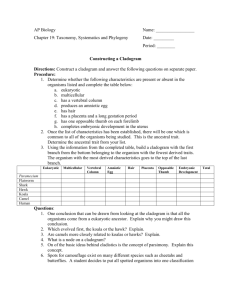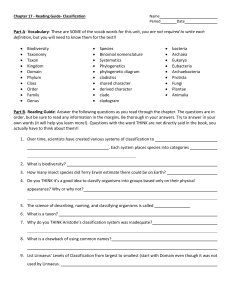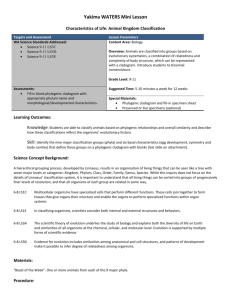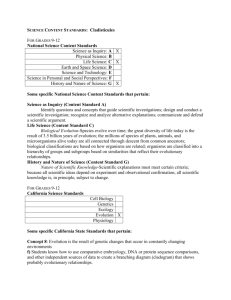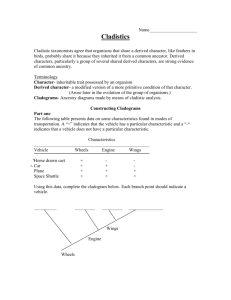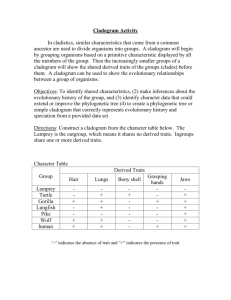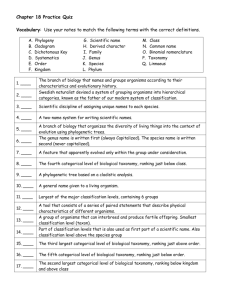Classification and Cladograms From your reading, you probably
advertisement
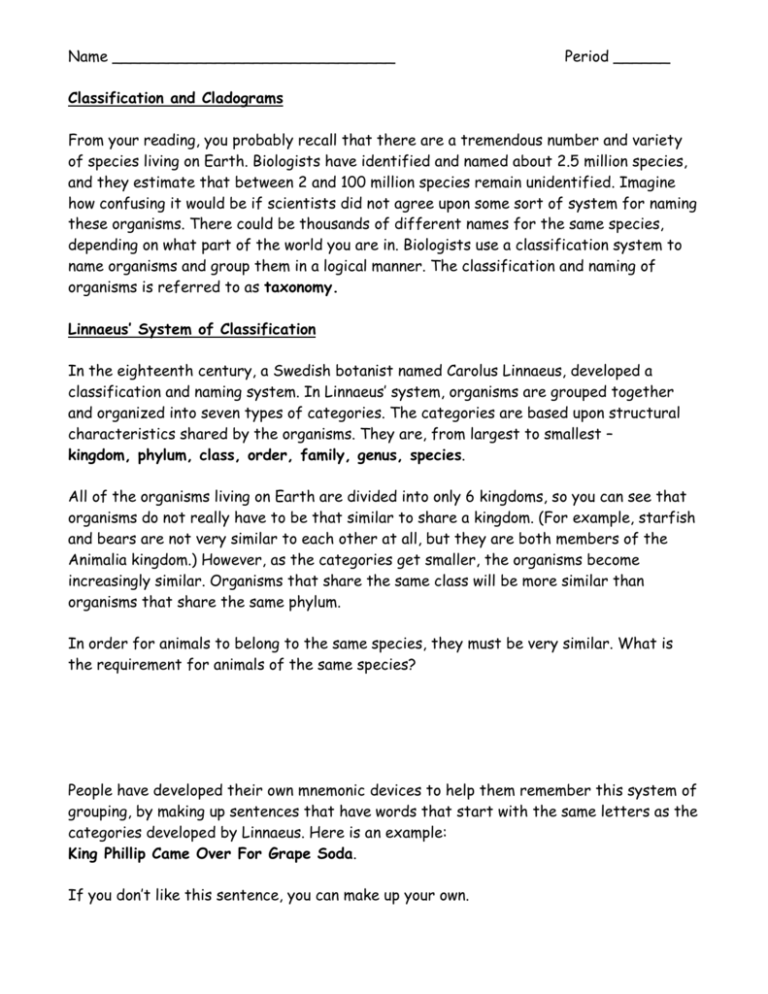
Name ______________________________ Period ______ Classification and Cladograms From your reading, you probably recall that there are a tremendous number and variety of species living on Earth. Biologists have identified and named about 2.5 million species, and they estimate that between 2 and 100 million species remain unidentified. Imagine how confusing it would be if scientists did not agree upon some sort of system for naming these organisms. There could be thousands of different names for the same species, depending on what part of the world you are in. Biologists use a classification system to name organisms and group them in a logical manner. The classification and naming of organisms is referred to as taxonomy. Linnaeus’ System of Classification In the eighteenth century, a Swedish botanist named Carolus Linnaeus, developed a classification and naming system. In Linnaeus’ system, organisms are grouped together and organized into seven types of categories. The categories are based upon structural characteristics shared by the organisms. They are, from largest to smallest – kingdom, phylum, class, order, family, genus, species. All of the organisms living on Earth are divided into only 6 kingdoms, so you can see that organisms do not really have to be that similar to share a kingdom. (For example, starfish and bears are not very similar to each other at all, but they are both members of the Animalia kingdom.) However, as the categories get smaller, the organisms become increasingly similar. Organisms that share the same class will be more similar than organisms that share the same phylum. In order for animals to belong to the same species, they must be very similar. What is the requirement for animals of the same species? People have developed their own mnemonic devices to help them remember this system of grouping, by making up sentences that have words that start with the same letters as the categories developed by Linnaeus. Here is an example: King Phillip Came Over For Grape Soda. If you don’t like this sentence, you can make up your own. Here is an example of the classification of a grizzly bear under the Linnaeus system. As you can see, as we progress from kingdom to species, the grizzly shares it classification with less and less organisms. This is because the categories get more and more specific, as they should in any useful classification system. Binomial Nomenclature Linnaeus’ system of classification has led to the development of a system for the scientific naming of organisms using a two-word naming system called binomial nomenclature. Each species is assigned a two-part scientific name. The scientific name is always written in italics, the first word is always capitalized, and the second word is lowercase. For example, the grizzly bear is called Ursus arctos. The first part of the name is always the genus of the organism, and the second part of the name is the species. You may remember from the Do Now reading several days ago that the peppered moth’s scientific name is Biston betularia. What genus does the peppered moth belong to? ________________ What species? ________________ Evolutionary Classification Darwin’s theory of evolution changed the way that biologists thought about classification. Scientists began to understand that organisms share certain traits because they share an evolutionary history. Biologists now group organisms into categories that represent lines of evolutionary descent, not just physical similarities. To contrast this with Linnaeus’ System of classification, the new method is called Evolutionary Classification. Classifying animals by their evolutionary relationships is not always easy to do at first sight. It requires a fairly sophisticated understanding of the history of life. A diagram that shows the evolutionary relationships among a group of organisms is called a cladogram. Here is an example of a cladogram. Notice how characteristics such as “jaws” and “fur” appear at certain locations along the branches of the cladogram. These locations are the points at which these characteristics first arose. You can see that lizards, birds, mice, and chimps share claws or nails, while salamanders, perch and hagfish do not have this characteristic. Cladograms are useful tools that help scientists understand how one group of organisms branched from another during the course of evolution. Quick Lab: Constructing a Cladogram Purpose To create a cladogram for a group of organisms. Procedure 1. Identify the organism in the table that is least closely related to the others. (Look for the organism that lacks at least one characteristic that all of the other organisms share.) ex. In the cladogram above, the hagfish does not have jaws, while all of the other organisms do. This means that the hagfish is the least related to the other organisms. 2. The organism identified in step 1 should be the first branch off of the main “line” of your cladogram. Draw your cladogram on a separate sheet of paper! ex. In the cladogram on the previous page, the hagfish is the first branch off the cladogram. 3. Write in the trait that the organism does not share on the main line of the cladogram, following the branch for your organism. ex. In the cladogram on the previous page, “jaws” is written on the main line, following the branch for the hagfish, because the hagfish does not have jaws. 4. Use the information in the table to complete the cladogram of these animals. Data Table Derived Characters in Organisms Derived Character Organism Backbone Legs Hair Earthworm Absent Absent Absent Trout Present Absent Absent Lizard Present Present Absent Human Present Present Present Analyze and Conclude – Answer in complete sentences. 1. What trait separates the least closely related organism from the other animals? 2. Does your cladogram indicate that lizards and humans share a more recent common ancestor than either does with an earthworm? Explain. Your explanation should include the characteristics that a common ancestor of lizards and humans would have. 3. If you added a frog to your cladogram, where would you put it? Explain. 4. If you added a dog to your cladogram, where would you put it? Explain.


